-
The finished Thomas Mace keyboard
The finished Thomas Mace keyboard
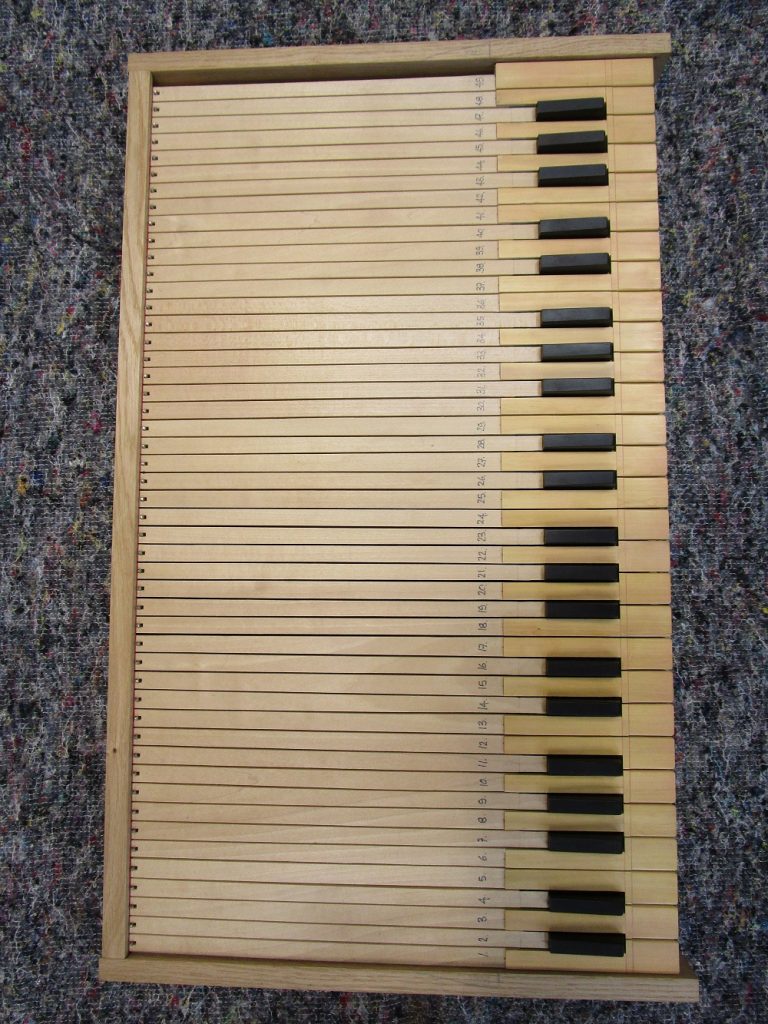
-
Edward cutting out the keys
Edward cutting out the keys

-
Cutting out the boxwood natural overlays
Cutting out the boxwood natural overlay for the Thomas Mace keys

-
Edward making the keys for the Thomas Mace table organ
Edward has been making the keys for the Thomas Mace table organ. They can be longer than the keys usually are for the chamber organs of the period, but the dimensions and the decorative overlay is based on those, like the anonymous ca1675 chamber organ now at Canons Ashby.

-
Silas and Dominic with the Italian chamber organ and a chest organ by Walter Chinaglia
The recording is of Italian music for cornett and organ, using our chamber organ (based on a ca1700 Italian chamber organ which we restored for Sheila Lawrence) and an extended chest organ with wooden pipes (an ‘organo di legno) by Walter Chinaglia. Gawain Glenton is playing the cornett and Silas Woolston the organs.

Silas and Dominic with the Italian chamber organ and a chest organ by Walter Chinaglia
-
Silas Wollston playing the Italian chamber organ with cornett player Gawain Glenton controlling stops for a recording at St Saviour Hampstead
Our Italian chamber organ has been used for a recording by Delphian Records https://www.delphianrecords.com/ in St Saviour Hampstead, thanks to the Rev Paul Nicholson. You can read about the project on http://www.gawainglenton.com/ and contribute to it on https://www.crowdfunder.co.uk/labrillantina
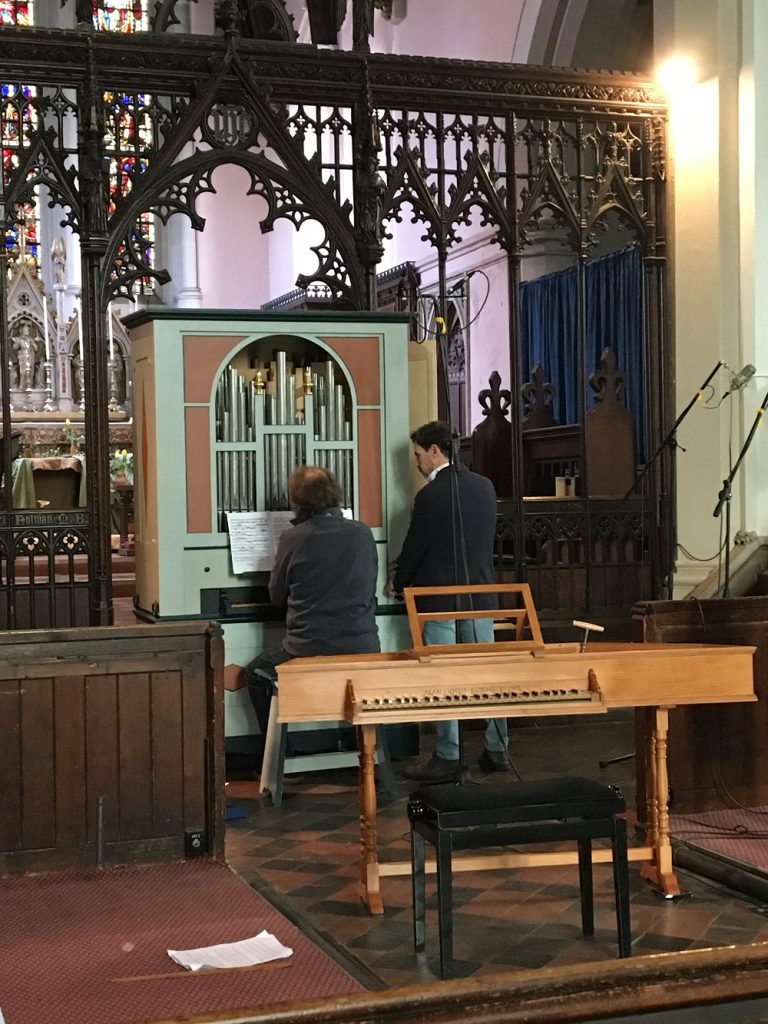
Silas Wollston playing the Italian chamber organ with cornett player Gawain Glenton controlling stops for a recording at St Saviour Hampstead
-
The Pilcher chamber organ in position
The organ is in a large practice room overlooking the Thames. The intriguing arrangement of wires making up the front was a solution by Edward and his brother Henry. The pins in the frame would originally have held pleated silk, in the form of a sunburst.

-
The moving team, Dominic, Tarja and Edward Bennett.
The moving team, Dominic, Tarja and Edward Bennett.

-
Moving a ca1830 Pilcher chamber organ to the City of London School
We moved a ca1830 William Pilcher chamber organ to the City of London School. It used to belong to Edward, and has been bought by Justin Berg, an American musician and musicologist. His plans for it have been put on hold, so it has spent a few months in St Peter Vauxhall while we were restoring the Lewis organ there, and has now been loaned to the City of London School. It is a delightful house organ by a little known organ builder. Pilcher was also known as a piano maker, and this organ has a keyboard which was originally intended for a piano, which may partly account for its five octave compass. The keyboard is hinged and folds up when not in use.

-
Wurlitzer at Saltaire 2
After our workshop restoration of the actions and business end, we installed the huge Nicholson made resonators.

-
Wurlitzer at Saltaire
Coming out of lock down and seeing venues look towards re-opening, and looking forward to being able to attend concerts again, has reminded me to share some pictures of some resent work we have done for the Cinema Organ Society (COS), on their Northern District organ installed at Victoria Hall, in the lovely Yorkshire town of Saltaire. This fine Wurlitzer theatre pipe organ is much traveled, and in the course of it’s five homes slightly enlarged, but also, unfortunately, slightly reduced! At some time in the past the lowest four resonators of the 16’ Wood Diaphone pipes were destroyed, so replacements had to be made, whilst they were good in themselves, they were the wrong scale, by a significant margin. So, at the behest of the COS, and in conjunction with Nicholsons & co. a plan was made to replace these mammoth pipes, with larger pipes of the correct scale, and restore the beaters and actions upon which they sit.
The first picture shows the vibrator units and chests as delivered to the workshop and in the second picture the vibrator units show the beater disks, and new Poplar timber to replace the water damaged material.
-
Theatr Soar the swell box in position
To convert the chapel into a performing space with the dance studio below, the floor has been inserted at gallery level, at about the height of the Great wind chest.

-
Theatr Soar lifting the Swell wind chest
The Swell wind chest being brought to the top floor by Edward, Joe and Chris (and Dominic taking the picture) before being man-handled onto the support structure
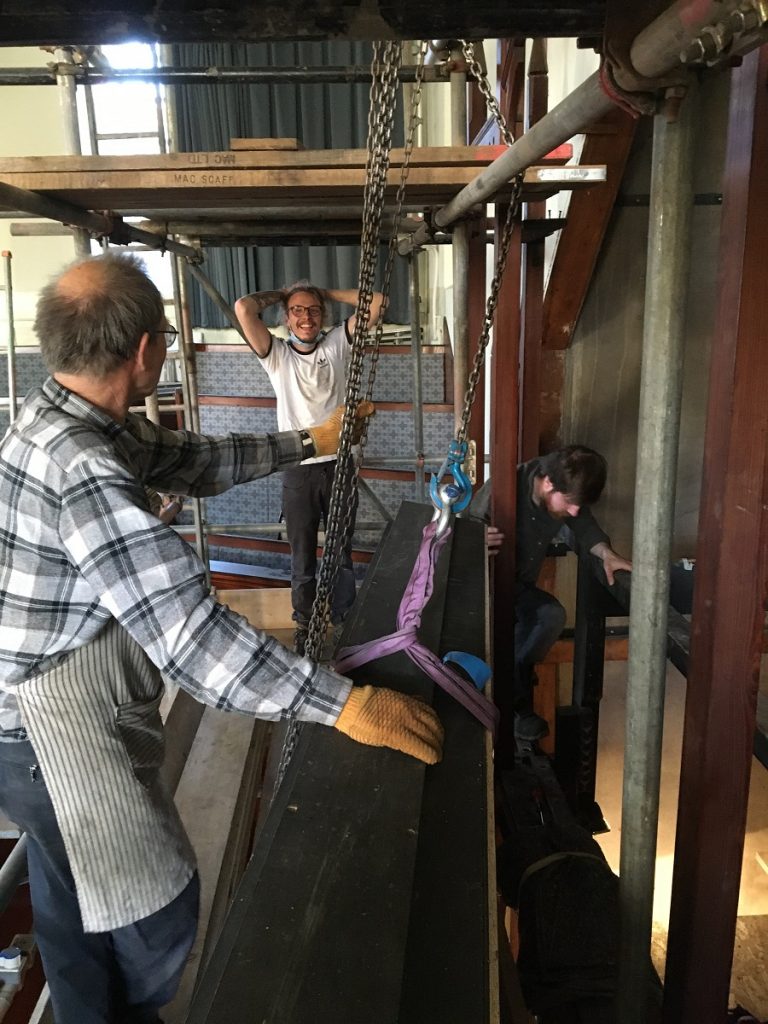
-
Theatr Soar lifting the Swell wind chest
The Swell wind chest being hoisted through the scaffolding in front of the organ…

-
Theatr Soar Conacher destination label
This is included for its beautiful if eccentric hand-writing. Goetze and Gwynn just took the parts in a van…

-
Theatr Soar bellows in position
The 1893 Peter Conacher organ was built over four levels, the bellows below the console, the mechanism to the Great wind chest, the Great chest and pipes, and the Swell chest, pipes and box above.

-
Theatr Soar Merthry Tydfil: the bellows being moved by Edward and Rob out of the Dance and Exercise studio
On March 14th – 16th 2021 the restored wind chests, bellows and swell box was moved back to Theatr Soar. The project has been somewhat held up by the present conditions, but the heavy parts are now back while the scaffolding and hoist are still in place.

-
Wynnstay organ: Art and Stuff
I was reading the Art Fund quarterly magazine, and a picture of the Wynnstay organ in the National Museum of Wales in Cardiff caught my eye. It led me on to an Art Fund podcast: https://www.listennotes.com/podcasts/art-and-stuff/the-wynnstay-organ-ykjSzhbGCZt/ It has to be said that you don’t hear the organ much (Andrew Willson Dickson) with snatches of Thomas Chilcot, and the commentary is not quite as factually reliable as it should be, but the variety of reactions to this lovely organ is fascinating.

-
The cleaned and repaired Swell Gemshorn
Joe has cleaned and repaired the Swell Gemshorn for the 1890 Peter Conacher organ at Theatr Soar, Merthyr Tydfil
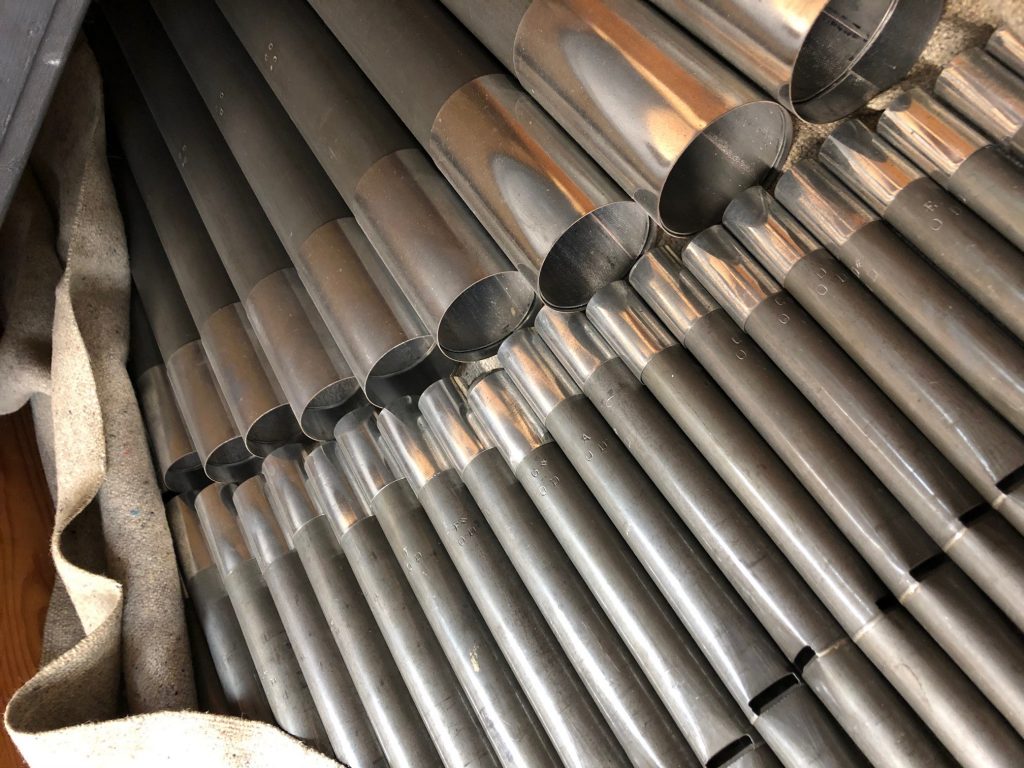
-
Edward working on the Swell Windchest
Edward working on the Swell Windchest on the restoration of 1890 Peter Conacher organ at Theatr Soar, Merthyr Tydfil. He is burning through the glue soaked cotton tape inside each individual wind bar, this is done to ensure structural integrity and minimise the chances of future runnings.

-
Trinity College Dublin Chair case plinth joining new to old
Trinity College Dublin Chair case plinth joining new to old

-
Trinity College Dublin Chair case new carved friezes for the plinth side returns
Trinity College Dublin Chair case new carved friezes for the plinth side returns
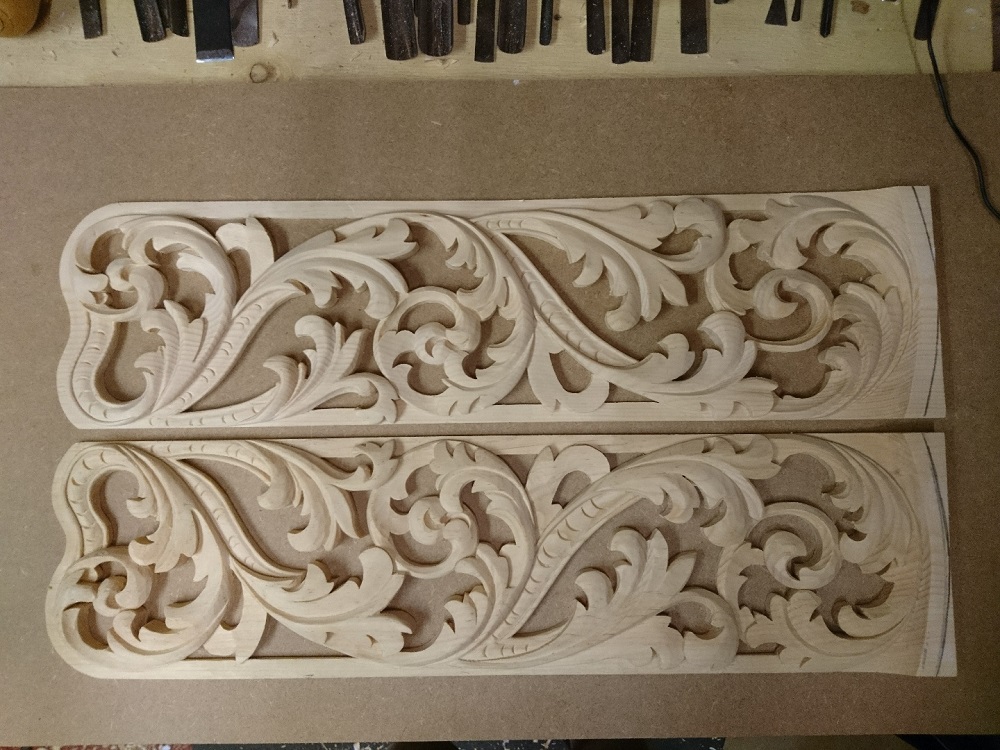
-
Trinity College Dublin Chair case replacement carved panels
The metal sheet behind the tower pipe shades had also been used to disguise missing carved panels. Nick copied the surviving originals. He did similar repairs to the frieze carving on the plinth, made new carvings in the same style for the sides, and gilded them.

-
Trinity College Dublin Chair case tower shades during restoration
Trinity College Dublin Chair case tower shades during restoration

-
Trinity College Dublin Chair case tower cap pre-restoration
The Chair case was made in 1705, also of pine. This picture shows the dark brown paint applied after 1945, and the chocolate paint covering the front pipes. The gilding was applied to honour an honorary fellowship awarded to the King of Spain in 1981.

-
Trinity College Dublin Great case middle tower with restorer
Nick fitting the roofs of the 1684 Great case towers, before fitting the supports for the royal arms on the centre tower, and those for Dublin and the College on the side towers.
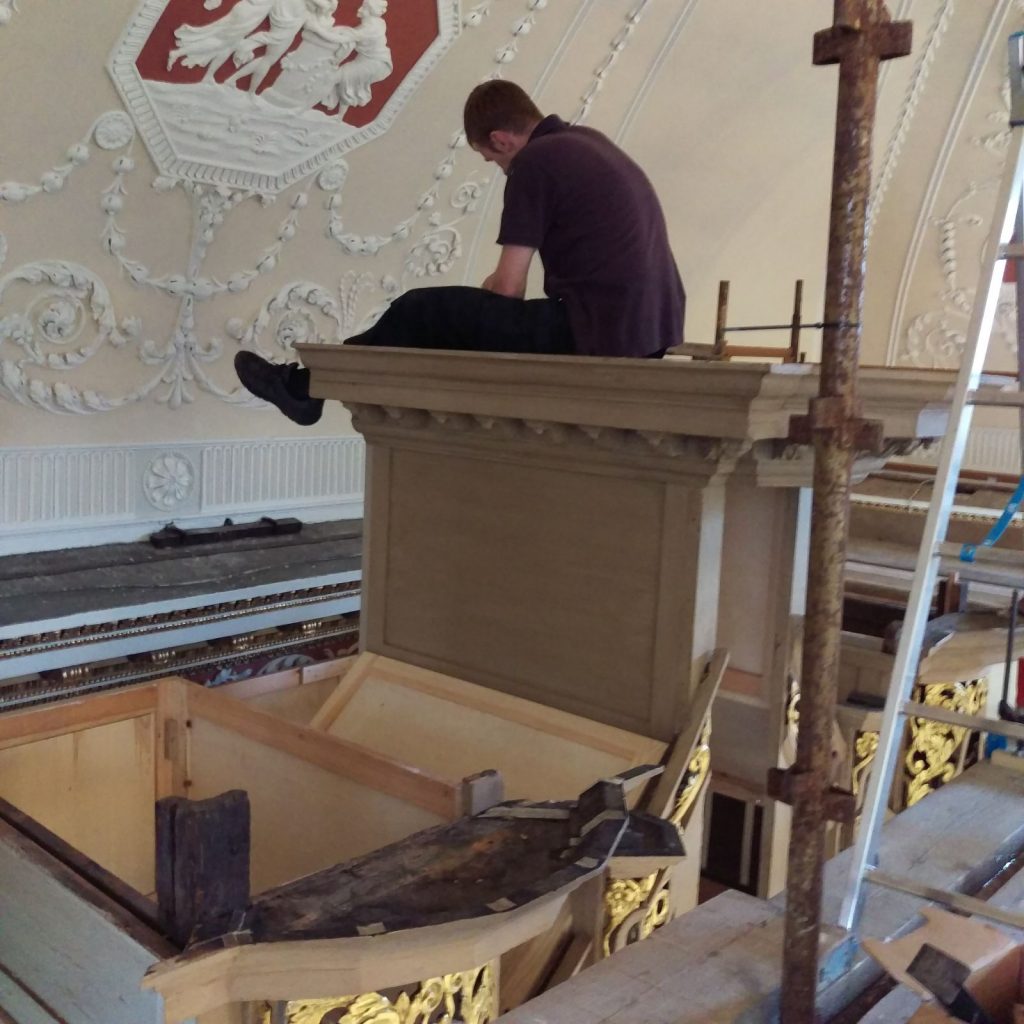
-
Trinity College Dublin Chair case new side and back panels and frames
A view of the Chair organ from the Great wind chest, showing the case without the tower caps and roofs. The front had survived as a screen, fortunately with enough evidence at the corners to show what the side panels looked like. When the organ was moved to the Public Theatre in the 1790s the Chair organ was placed behind the gallery railing, almost as if the move was temporary. It now projects through the rail, as it should, supported on hefty beams supplied in the 1790s. Apart from these and the damaged front, the Chair case is all Nick’s work.

-
Trinity College Dublin Great case new return panels and mouldings
Much of the top case was intact, though it still needed a new back frame, new roofs and return panels to the towers and new mouldings, where the originals had been removed in 1839. Not surprisingly, putting all this back helped to stabilize the case. In this picture the front frame still has its post-War paint and gilding.

-
Trinity College Dublin fitting the case panels and mouldings
The 1684 case was constructed in a way that meant it could only be re-assembled completely on site, with some of the mouldings added after assembly of the panel frames, etc. It had also been nailed and patched over the centuries to such an extent that almost every joint and edge had had to be strengthened and neatened with new wood. The original cases were made of pine. Fortunately the whole case had been painted repeatedly. It now has the colour of the 1705 casework, applied by Charles and Liz Marsden, here being touched up by Nick.

-
Trinity College Dublin side view
Trinity College Dublin side view with restored Great case side panels and new Chair and Pedal case side panels



